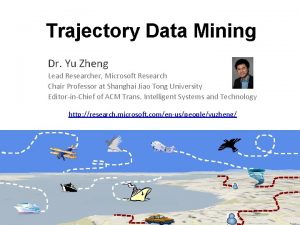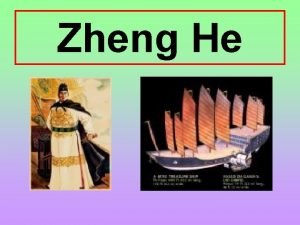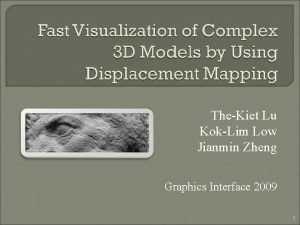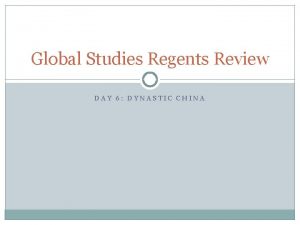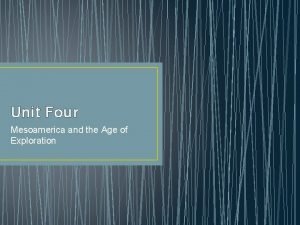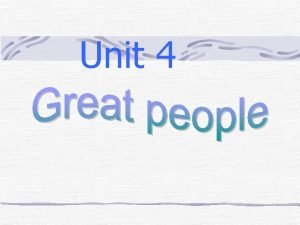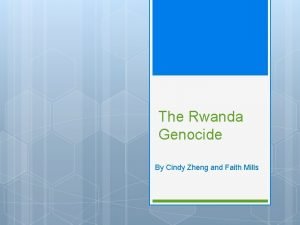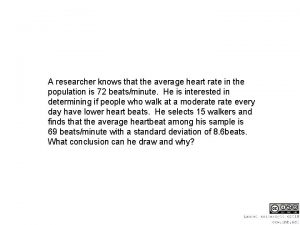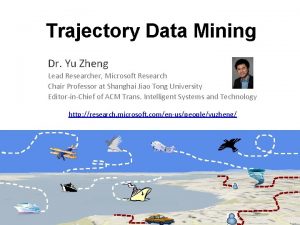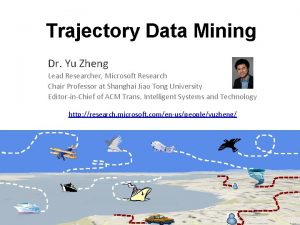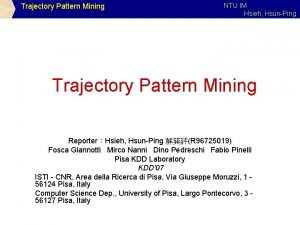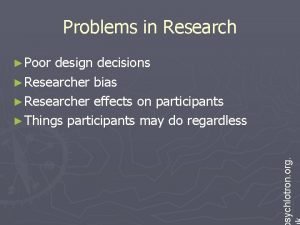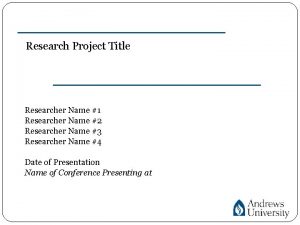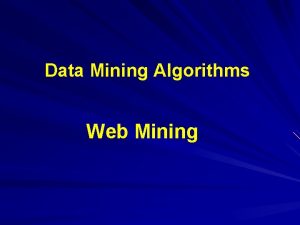Trajectory Data Mining Dr Yu Zheng Lead Researcher


































![Trajectory Data Management • Multi-version R-tree (HR-tree [Tao 2001 a], HR+-tree[Tao 2001 b], MR-tree[Xu Trajectory Data Management • Multi-version R-tree (HR-tree [Tao 2001 a], HR+-tree[Tao 2001 b], MR-tree[Xu](https://slidetodoc.com/presentation_image_h/bbc8f9e19d0f684c8cff7279c3b7611e/image-35.jpg)
















- Slides: 51

Trajectory Data Mining Dr. Yu Zheng Lead Researcher, Microsoft Research Chair Professor at Shanghai Jiao Tong University Editor-in-Chief of ACM Trans. Intelligent Systems and Technology http: //research. microsoft. com/en-us/people/yuzheng/

Paradigm of Trajectory Data Mining Yu Zheng. Trajectory Data Mining: An Overview. ACM Transactions on Intelligent Systems and Technology. 2015, vol. 6, issue 3.

Trajectory Data Management •

Trajectory Data Management •

Spatial Queries Nearest Neighbour Queries Given a point or an object, find the nearest object that satisfies given conditions Region (Range) Query Ask for objects that lie partially or fully inside a specified region.

Spatial Indexing Structures • Space Partition-Based Indexing Structures – Grid-based – Quad-tree – k-D tree • Data-Driven Indexing Structures – R-Tree

Spatial Indexing Structures • Space Partition-Based Indexing Structures – Grid-based – Quad-tree – k-D tree • Data-Driven Indexing Structures – R-Tree

Grid-based Spatial Indexing • Indexing – Partition the space into disjoint and uniform grids – Build inverted index between each grid and the points in the grid g 1 p 3 p 1 g 2 g 1 p 3 g 2 p 4

Grid-based Spatial Indexing • Range Query – Find the girds intersecting the range query – Retrieve the points from the grids and identify the points in the range p 4 p 2 p 1 p 3 g 1 p 2 p 4 g 2 p 3 g 4 p 1

Grid-based Spatial Indexing • Nearest neighbor query – Euclidian distance – Road network distance is quite different The nearest object is within the grid The nearest object is outside the grid p 2 p 1 Fast approximation p 2 p 1

Grid-based Spatial Indexing • Advantages – Easy to implement and understand – Very efficient for processing range and nearest queries • Disadvantages – Index size could be big – Difficult to deal with unbalanced data

Quad-Tree • Indexing – Each node of a quad-tree is associated with a rectangular region of space; the top node is associated with the entire target space. – Each non-leaf node divides its region into four equal sized quadrants – Leaf nodes have between zero and some fixed maximum number of points (set to 1 in example). 00 0 03 0 1 30 31 2 3 12 2 3 02 00 33 1 32 30

Quad-Tree • Range query 00 0 03 1 02 20 30 31 2 3 33 32 2 3 23

Quad-Tree • Nearest Neighbour Query (hard) 00 0 03 1 02 20 30 31 2 3 33 32 2 3 23

K-D-Tree Each line in the figure (other than the outside box) corresponds to a node in the k-d tree the maximum number of points in a leaf node has been set to 1. The numbering of the lines in the figure indicates the level of the tree at which the corresponding node appears. 15

K-D-Tree Example X=7 X=5 y=6 y=5 Y=6 x=3 Y=5 y=2 Y=2 X=3 X=5 X=8 x=7

K-D-Tree Example • Range query X=5 X=7 X=3 Q=(4, 7), (7, 5) y=6 y=5 x=3 Y=6 Y=5 y=2 Y=2 X=5 X=8 x=7

K-D-Tree • Nearest neighbor query

Spatial Indexing Structures • Space Partition-Based Indexing Structures – Grid-based – Quad-tree – k-D tree • Data-Driven Indexing Structures – R-Tree

R-Trees • Build a Minimum Bounding Rectangle (MBR) MBR = {(L. x, L. y)(U. x, U. y)} Note that we only need two points to describe an MBR, we typically use lower left, and upper right.

R-Trees • We can group clusters of data points into MBRs – Can also handle line-segments, rectangles, polygons, in addition to points R 1 R 2 R 4 We can further recursively group MBRs into larger MBRs…. R 5 R 3 R 6 R 9 R 7 R 8

R-Tree Structure • Nested MBRs are organized as a tree R 10 R 11 R 12 R 1 R 2 R 3 R 12 R 4 R 5 R 6 R 7 R 8 R 9 Data nodes containing points

Nearest Neighbour Search • Given an MBR, we can compute lower bounds on nearest object • Once we know there IS an item within some distance d, we can prune away all items/MBRs at distance > d – Even if we haven’t actually found the nearest item yet – Similar technique possible for k-d trees and quad-trees as well Q R 10 R 11 R 12 R 1 R 2 R 3 R 4 R 5 R 6 R 7 R 8 R 9 R 12 Data nodes containing points

Comparison among Spatial Indices Unbalanced data Range query Nearest neighbor Construc Balanced Storage tion structure Grid-based Poor Good Nomal Easy Yes Big Quad-Tree Good Best Poor Easy No Median KD-Tree Good Normal Good Easy Almost Median R-Tree Good Normal Best Difficult Yes Small

Trajectory Data Management •

Trajectory Data Management • Range queries E. g. Retrieve the trajectories of vehicles passing a given rectangular region R between 2 pm-4 pm in the past month • KNN queries E. g. Retrieve the trajectories of people with the minimum aggregated distance to a set of query points Publications: [1][2] for a single point query, [3] for multiple query points E. g. Retrieve the trajectories of people with the minimum aggregated distance to a query trajectory Publications: Chen et al, SIGMOD 05; Vlachos et al, ICDE 02; Yi et al, ICDE 98. [1] E. Frentzos, et al. Algorithms for nearest neighbor search on moving object trajectories. Geoinformatica, 2007 [2] D. Pfoser, et al. Novel approaches in query processing for moving object trajectories. VLDB, 2000. [3] Zaiben Chen, et al. Searching Trajectories by Locations: An Efficiency Study, SIGMOD 2010

Trajectory Data Management •

Trajectory Data Management • using an exponential function to assign a larger contribution to a closer matched pair of points while giving much lower value to those far-away pairs Zaiben Chen, et al. Searching Trajectories by Locations: An Efficiency Study, SIGMOD 2010

Trajectory Data Management •

Trajectory Data Management •

Trajectory Data Management •

Trajectory Data Management • Indexing structures • View temporal as an additional dimension – – – • Divides a time period into multiple time intervals a spatial index in each interval – – • 3 D R-Tree ST R-Tree TB-Tree HR-tree MR-tree HR+-tree MV 3 R-tree Partition a geographical space into grids a temporal index in each grid – CSE-Tree

Trajectory Data Management • R-Tree R 10 R 11 R 12 R 1 R 2 R 3 R 4 R 5 R 6 R 7 R 8 R 9 R 12 Data nodes containing points

Trajectory Data Management • 3 D R-tree Time y x
![Trajectory Data Management Multiversion Rtree HRtree Tao 2001 a HRtreeTao 2001 b MRtreeXu Trajectory Data Management • Multi-version R-tree (HR-tree [Tao 2001 a], HR+-tree[Tao 2001 b], MR-tree[Xu](https://slidetodoc.com/presentation_image_h/bbc8f9e19d0f684c8cff7279c3b7611e/image-35.jpg)
Trajectory Data Management • Multi-version R-tree (HR-tree [Tao 2001 a], HR+-tree[Tao 2001 b], MR-tree[Xu 2005]) For each timestamp, an R-tree is created. So, there are many R-trees. These R-trees are indexed. HR-tree [Tao 2001] Query for trajectories in a given region and in a given time interval: 1. The R-tree at the timestamp is found first 2. The trajectories in the specified region are retrieved from the R-tree.

CSE-Tree • Problem Definition – Retrieve the GPS trajectories across a given region and intersecting a given time span • Present techniques are not optimized to these applications Spatial query Temporal query

Index Design • Architecture – Partition space into disjoint grids – Maintain a temporal index for each grid – The temporal index (CSE-Tree) is special Longhao Wang, Yu Zheng, et al. A FLEXIBLE SPATIO-TEMPORAL INDEXING SCHEME FOR LARGE-SCALE GPS TRACK RETRIEVAL. MDM 2009

Temporal Index (CSE-Tree) • A GPS segment can be represented by a pair (Ts, Te) • A point on two dimensional plane • A temporal query is a time span (Timemin , Timemax) Timemin Ts Te Ts Timemax Ts Te Te

Temporal index • Structure – Partition the points into groups by Te – Build a start time index (B+ Tree) to index points of each group – Build a end time index (B+ Tree) to index groups Te ti+1 ti t 2 t 1 Ts

Temporal Index (CSE-Tree) • Search operation – Te> Timemin: Search End Time index to get the corresponding start time indexes – Ts< Timemax: Look up each start time index candidate to find the correct points

Temporal Index (CSE-Tree) • Compress operation – Occur when update frequency drops to some extent – Convert B+ tree to dynamic array B+ Tree dynamic array

More Elegant 1 3 4 6 11 7 Traj ID 1 i 1, j 1 Traj ID 1 p 1, p 2, … pk Traj ID 2 i 2, j 2 Traj ID 2 p 1, p 2, … pk Traj IDn in, jn Traj IDn p 1, p 2, … pk

KNN Point Queries • The problem we study: Searching by multiple locations – To find trajectories that are ‘close’ to all the locations • Technically, it is an extension of the single-location based query. But more complicated. • Practically, it produces a more general way to search trajectories. Two extreme cases (one location, many locations) Zaiben Chen, et al. Searching Trajectories by Locations: An Efficiency Study, SIGMOD 2010

KNN Point Queries The recommended route

Similarity Function • The similarity function reflects how close a trajectory is to the given locations, and we call the most similar trajectory the best-connected trajectory. – Step 1. find out the closest trajectory point on R to each location qi – Step 2. sum up the contribution of each matched pair. (unordered query) Distq(qi, R) is the shortest distance from qi to R Q={q 1, q 2, … qm}, R={p 1, p 2, … pn} Zaiben Chen, et al. Searching Trajectories by Locations: An Efficiency Study, SIGMOD 2010

KNN Point Queries • k-Best Connected Trajectory (k-BCT) query Given a set of trajectories T = {R 1, R 2, … , Rn}, a set of query locations Q = {q 1, q 2, … , qm}, and the similarity function Sim(Q, R), the k-BCT query is to find the k trajectories among T that have the highest similarity. Assumption: The number of query locations is small. (m is a small constant) Intuition: The k-BCT result is the JOIN of m single-location based queries.

Basic ideas Incremental k-NN Algorithm (IKNN) • Step 1. Index all the trajectory points by one single R-tree – Get the shortest distance from a query location to the trajectories • Step 2. Search for the λ-nearest neighbor (λ-NN) of each query location – using any traditional k-nearest neighbor algorithm over R-tree – Candidate set C = {all scanned trajectories} Zaiben Chen, et al. Searching Trajectories by Locations: An Efficiency Study, SIGMOD 2010

IKNN algorithm • Step 3. Construct lower bounds of similarity. For a trajectory R 1 in C, assume it got 3 points p 1, p 2 and p 3 scanned by the λ-NN search of q 1, q 2. p 5 p 1 q 1 Sim(Q, R 1) = p 2 R 1 p 3 q 2 q 3 e-|q 1, p 1| + e-|q 2, p 2| + e-|q 3, p 5| ≥ e-|q 1, p 1| + e-|q 2, p 2|

The Incremental k-NN algorithm • Step 4. Construct upper bound of similarity. For any trajectory that is not covered by the λ-NN search, e. g. R 5 it’s distance to qi must be larger than the radius of qi radius 1 q 1 radius 2 q 2 radius 3 R 1 q 3 R 5 Sim(Q, R 5) = e-|q 1, R 5| + e-|q 2, R 5| + e-|q 3, R 5| ≤ e-radius 1+ e-radius 2 + e-radius 3

The Incremental k-NN algorithm • Step 5. Check the STOP condition (pruning condition) For a k-BCT query, if we can get k candidate trajectories whose lower bounds are not less than the upper bound of similarity for all un-scanned trajectories, then the k best-connected trajectories must be included in the candidate set. if the condition is satisfied go to the refinement step else increase λ by some Δ repeat the search process With the search region of the λ-NN search enlarges, eventually k best-connected trajectories will be found Zaiben Chen, et al. Searching Trajectories by Locations: An Efficiency Study, SIGMOD 2010

Thanks! Yu Zheng yuzheng@microsoft. com Homepage Yu Zheng. Trajectory Data Mining: An Overview. ACM Transactions on Intelligent Systems and Technology. 2015, vol. 6, issue 3.
 Trajectory data mining an overview
Trajectory data mining an overview Eck
Eck Mining multimedia databases
Mining multimedia databases Strip mining vs open pit mining
Strip mining vs open pit mining Mineral resources and mining chapter 13
Mineral resources and mining chapter 13 Difference between strip mining and open pit mining
Difference between strip mining and open pit mining Difference between text mining and web mining
Difference between text mining and web mining Data reduction in data mining
Data reduction in data mining What is data mining and data warehousing
What is data mining and data warehousing What is missing data in data mining
What is missing data in data mining Concept hierarchy generation for nominal data
Concept hierarchy generation for nominal data Data reduction in data mining
Data reduction in data mining Data reduction in data mining
Data reduction in data mining Data cube technology in data mining
Data cube technology in data mining Data reduction in data mining
Data reduction in data mining Data warehouse dan data mining
Data warehouse dan data mining Data mining dan data warehouse
Data mining dan data warehouse Datamart olap
Datamart olap Mining complex data objects
Mining complex data objects Data warehousing olap and data mining
Data warehousing olap and data mining Noisy data in data mining
Noisy data in data mining Three tier data warehouse architecture
Three tier data warehouse architecture Data preparation for data mining
Data preparation for data mining Data compression in data mining
Data compression in data mining Introduction to data warehouse
Introduction to data warehouse Data warehouse dan data mining
Data warehouse dan data mining Cs 412 introduction to data mining
Cs 412 introduction to data mining Lead magnesium niobate/lead titanate
Lead magnesium niobate/lead titanate What was zheng he looking for
What was zheng he looking for Jianmin zheng
Jianmin zheng Lida zheng northwestern
Lida zheng northwestern This map shows that the silk road
This map shows that the silk road Should we celebrate the voyages of zheng he essay
Should we celebrate the voyages of zheng he essay This color signifies coolheadedness
This color signifies coolheadedness Bojian zheng
Bojian zheng Zuyin zheng
Zuyin zheng Zheng
Zheng Zheng he
Zheng he Shuran zheng
Shuran zheng Cindy zheng
Cindy zheng Whyjay zheng
Whyjay zheng Icc arbitration hong kong
Icc arbitration hong kong Zheng jiang history
Zheng jiang history Types of educational research
Types of educational research Sampling method in research
Sampling method in research Non contrived adalah
Non contrived adalah Learning competency code
Learning competency code Think like a researcher
Think like a researcher Limang uri na kailangang magtaglay sa konseptong papel.
Limang uri na kailangang magtaglay sa konseptong papel. American researcher who involved in getting heart rate
American researcher who involved in getting heart rate What are the habits of a good researcher
What are the habits of a good researcher Thinking like a researcher
Thinking like a researcher
